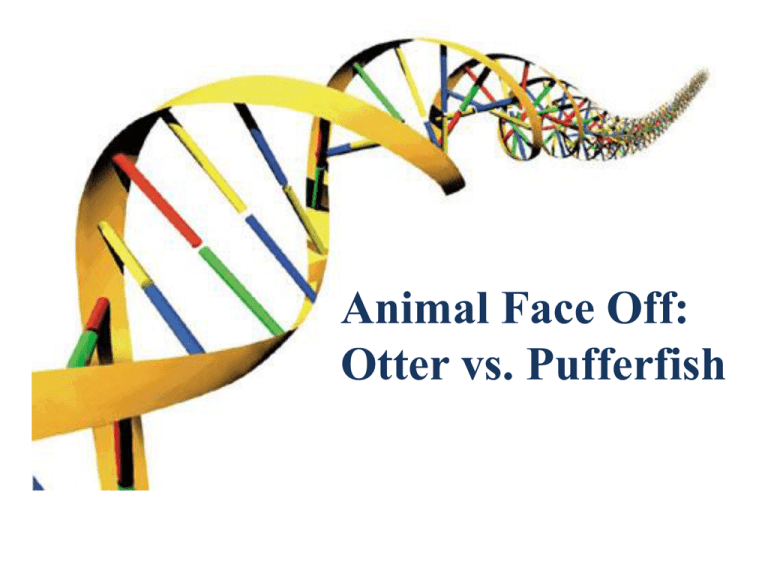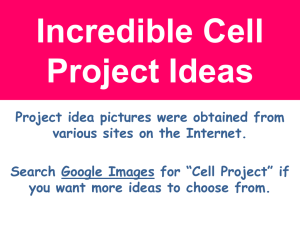File
advertisement

Animal Face Off: Otter vs. Pufferfish The universe is written in the language of mathematics ◦ Galileo Galilei, 1623 Quantitative analysis of natural phenomena is at the heart of scientific inquiry Nature provides a tangible context for mathematics instruction Context 1. The part of a text or statement that surrounds a particular word or passage and determines its meaning. 2. The circumstances in which an event occurs; a setting. Context-Specific Learning ◦ Facilitates experiential and associative learning Demonstration, activation, application, task-centered, and integration principles (Merrill 2002) ◦ Facilitates generalization of principles to other contexts Geometry & Biology ◦ Biological structures vary greatly in geometry and therefore represent a platform for geometric education ◦ Geometric variability functional variability Mechanism for illustrating the consequences of geometry Geometry & Biology ◦ Ecological interactions can be affected by the geometry of anatomical structures Competition Two organisms in pursuit of the same resource Principle of Competitive Exclusion Ecological niche Geometric variability is the “ghost of competition past” (Reece et al. 2009) Geometry & Biology ◦ Ecological interactions can be affected by the geometry of anatomical structures Mouth size is an extremely important geometric parameter Predators with large mouths have a competitive advantage Large prey greater energetic return per unit effort (Herrel et al., 2001; Roughgarden,1995) D.Huber (2012) Geometry & Biology ◦ Ecological interactions can be affected by the geometry of anatomical structures Mouth size is an extremely important geometric parameter Predators with large mouths have a competitive advantage Large prey greater energetic return per unit effort (Herrel et al., 2001; Roughgarden,1995) Geometric winners and losers Large-mouthed predators out compete small-mouthed predators Large prey outlast small prey Geometry & Biology ◦ Ecological interactions can be affected by the geometry of anatomical structures But what about prey that change geometry??? Otter vs. Pufferfish Insert Video of Pufferfish here Pufferfish.mpg The incredible, inflatable pufferfish ◦ Inflation mechanism (Wainwright and Turingan 1997) Water pumped into expandable stomach Extensible skin, no ribs The incredible, inflatable pufferfish ◦ Inflation mechanism (Wainwright and Turingan 1997) Water pumped into expandable stomach Extensible skin, no ribs vs. M. Dowland (2006) Flippers 'n' Fins (2004) Geometry & Biology ◦ Geometry Objectives MA.912.G.4.6 Prove that triangles are congruent or similar and use the concept of corresponding parts of congruent triangles. MA.912.G.6.4 Determine and use measures of arcs and related angles (central, inscribed, and intersections of secants and tangents). Geometry & Biology ◦ Geometry Objectives MA.912.G.6.5 Solve real-world problems using measures of circumference, arc length, and areas of circles and sectors. MA.912.G.8.2 Use a variety of problem-solving strategies, such as drawing a diagram, making a chart, guess-and-check, solving a simpler problem, writing an equation, and working backwards. The incredible, inflatable pufferfish ◦ The otter’s jaws are modeled as tangents to the pufferfish. Otter Jaw Pufferfish Gape Angle The incredible, inflatable pufferfish ◦ Given The otter’s jaws are tangent to the pufferfish. x₁ and x2 represent arc measurements in degrees. 1) What is the measurement of x1 + x2? • 360 Otter Jaw Pufferfish Gape Angle The incredible, inflatable pufferfish ◦ Given The otter’s jaws are tangent to the pufferfish. x₁ and x2 represent arc measurements in degrees. 2) Write an equation relating x1 and x2 to the measure of ABC. • 𝑥1 −𝑥2 2 = 46° Otter Jaw Pufferfish Gape Angle The incredible, inflatable pufferfish ◦ Given The otter’s jaws are tangent to the pufferfish. x₁ and x2 represent arc measurements in degrees. 3) Use your answers to the previous questions to find x1 and x2. • 𝑥1 + 𝑥2 = 360° • 𝑥1 −𝑥2 2 Otter Jaw = 46° Pufferfish Gape Angle The incredible, inflatable pufferfish ◦ Given The otter’s jaws are tangent to the pufferfish. x₁ and x2 represent arc measurements in degrees. 3) Use your answers to the previous questions to find x1 and x2. • 𝑥1 + 𝑥2 = 360° • 𝑥1 −𝑥2 2 = 46° • 𝑥1 = 226° • 𝑥2 = 134° The incredible, inflatable pufferfish ◦ Given The otter’s jaws are tangent to the pufferfish. x₁ and x2 represent arc measurements in degrees. 4) Draw AC and label its midpoint H. Draw DB. Otter Jaw Pufferfish Gape Angle The incredible, inflatable pufferfish ◦ Given The otter’s jaws are tangent to the pufferfish. x₁ and x2 represent arc measurements in degrees. 4) Draw AC and label its midpoint H. Draw DB. The incredible, inflatable pufferfish ◦ Given The otter’s jaws are tangent to the pufferfish. x₁ and x2 represent arc measurements in degrees. 5) Name every triangle drawn in the picture that is similar to △BHA. • • • • • △BHC △AHD △CHD △BAD △BCD The incredible, inflatable pufferfish ◦ Given The otter’s jaws are tangent to the pufferfish. x₁ and x2 represent arc measurements in degrees. 6) Find the radius, r, of the circle to two decimal places. • r = 3.82 cm The incredible, inflatable pufferfish ◦ Given The otter’s jaws are tangent to the pufferfish. x₁ and x2 represent arc measurements in degrees. 7) What is the diameter of the largest pufferfish that this otter can eat? • d = 7.64 cm The incredible, inflatable pufferfish ◦ Given The otter’s jaws are tangent to the pufferfish. x₁ and x2 represent arc measurements in degrees. 7) What is the diameter of the largest pufferfish that this otter can eat? • d = 7.64 cm References ◦ Galileo Galilei, The Assayer, as translated by Stillman Drake (1957), Discoveries and Opinions of Galileo pp. 237-8. New York: Doubleday & Company. ◦ Herrel, A., R. Van Damme, B. Vanhooydonck and F. De Vree (2001) The implications of bite performance for diet in two species of lacertid lizards. Can. J. Zool. 79: 662670. ◦ Merrill, M.D. (2002). First principles of instruction. Educational Technology Research and Development. 50 (3): 43 – 59. ◦ Reece, J.B., Urry, L.A., Cain, M.L., Wasserman, S.A., Minorsky, P.V., and Jackson, R.B. (2009). Campbell Biology, 9th Edition. Benjamin Cummings. San Francisco, CA. ◦ Roughgarden, J. 1995. Anolis lizards of the Caribbean. Oxford University Press, New York. ◦ Wainwright, P. C. and R. G. Turingan. 1997. Evolution of pufferfish inflation behavior. Evolution. 51:506-518.



